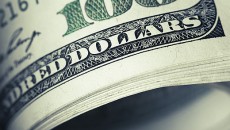Currencies – EUR/USD
This week the global currency market had heavy activity, specifically with the Euro and USD. The overall trade was Dollar strength and Euro weakness, which could be observed in the EUR/USD pair. Since January 12, the pair declined 3.38% (as of January 21); a considerable move for the pair of currencies. A decline in the EUR/USD means that it takes less Dollars to buy Euros. There were notable drivers in both the fundamental and technical aspects of each currency.
A key fundamental driver that directly advocated USD strength, without factoring that it is the world’s reserve currency, was the Republican victory in Massachusetts. The reason for this is that the majority believe that having Brown in the Senate will be what holds back the health care bill and government spending. This is positive for the USD, and allowed for investors to reassess the situation; as there had been a USD selloff for most of 2009, with the theme that the US will take on massive debt with no plan to repay. On the other side of the trade, the opposite is happening in the Eurozone with Greece’s spiraling debt and financial crisis. The country’s government bonds were being sold off, giving Greece higher borrowing costs. To top off the fire sale of Greece debt, the country’s stock market was hit over 5%. This has investors speculating that Greece may be released from the European Union, sparking worry about the financial stability of the Eurozones other members, such as Germany, who had a low investor sentiment this week. As noted by the chief currency strategist at Gain Capital on his outlook for this year, “In 2010, countries who control their deficit and repair their balance sheet will be rewarded by investors”. Along with this, China’s actions have investors worried. This week, China released statements that instruct its banks to restrain their current lending practices. This means a tightening of credit flow in the emerging market, instigating concern that world recovery may come to a halt. Although some investors believe this could be positive when looking long term, it created a sort of panic among most short term traders.
Another important catalyst bringing down the EUR/USD pair was the technical price action. Since December 2, the pair had been in a steep down trend, breaking through previous lows and finally slowing down at the 200 day moving average on December 21 (see graph below). After retracing 38.2% (important for followers of the Fibonacci theory) the pair continued its decline. After the 50 day SMA (simple moving average) crossed down and through the 100 day SMA, the pair finally broke through the 200 day moving average, signaling a continuation in the broader downtrend and a heavy overnight sell off.
-A.Tarhini
The World’s Biggest Confectioner: Kraft to acquire Cadbury
The American food-giant, Kraft, has sweetened its offer to acquire Cadbury, a UK based confectioner, for 11.9bn ($19.3bn). Kraft was able to silence one bidder, Nestle, after selling its American pizza business to them for $3.7bn earlier in the month. Afterwards, Kraft decided to use the proceeds and issue 265 million shares to increase its offer to $19.3bn, a 50% premium. Hershey then abandoned its bid for Cadbury. This is the third time in eight years that Hershey has failed to combine with England-based Cadbury.
Warren Buffet has deemed this deal a “mistake”, stating that the company was issuing too many undervalued shares which would dilute shareholder value. Buffet believes that Kraft’s shares are now not undervalued by the margin it used to be. Additionally, Buffet stated that the $3.7bn proceeds received from selling off its pizza business to Nestle was tax inefficient because Kraft only received $2.5bn after taxes. He states that he will continue being a Kraft shareholder.
The acquisition will create the world’s largest confectioner; surpassing Marc Inc. Hershey was the biggest US confectioner until 2008 when Virginia-based Mars acquired Wm. Wrigley Jr. Co for $23bn. The deal is also set to yield cost savings of $675mn a year. Hershey’s withdrawal from the process is good news for its bondholders, who expected the bonds to slip below investment grade with the burden required to acquire Cadbury. However, it will be relatively hard for Hershey to compete globally as a company that’s one-third the size of its two largest competitors. Kraft held 4.7%, Cadbury holds 10.2%, and Hershey held 4.6%.
– A. Medina
Current Events and the Market
Healthcare stocks pushed the S&P ten points higher Tuesday, on speculation that the republican candidate Scott Brown would be elected in Massachusetts. Running as the 41st vote against the healthcare overhaul bill, Republican Scott Brown managed to secure victory. Investors seemed to believe that the Republican’s election to the senate was indicative of the end of the healthcare bill’s passage through congress. As a result, traders argue, prices began to bid up on Monday. Other traders said that the election had already been priced in by early Tuesday and were validated by a downturn in the stock market on Wednesday. However, the downturn on Wednesday is widely believed to be the result of negative bank earnings. Among the banks that missed earnings were Bank of America and Morgan Stanley. On Thursday, Goldman Sachs posted earnings that beat analysts’ estimates. However, the stock market still tumbled over two hundred points after President announced that among the regulatory reform bill already endorsed, there is intended to be provisions that would prohibit banks who accept deposits from owning hedge funds and from engaging in proprietary trading. This regulatory change would essentially bring back some provisions from the 1933 Glass Steagall Act which was repealed under the Clinton administration. Among other economic data, unemployment Claims came in worse than expected. The market ended the week on Friday another 216 points down.
– R. Belsky
Article submitted by: Alex Tarhini, Alejandro Medina and Robert Belsky of the Capital Markets Lab (CML). To learn more about the Capital Markets Lab please visit https://business.fiu.edu/capital-markets-lab/.






